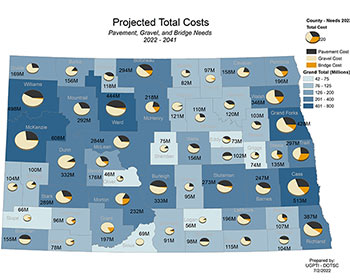UGPTI Nears Completion of Biennial Local Road Investment Needs Study
Posted: Aug 16, 2022
 North Dakota will need to invest more than $10.5 billion over the next 20 years to maintain local, township, and tribal roads and bridges according to a study by the Upper Great Plains Transportation Institute at North Dakota State University. That amount includes $6.5 billion for unpaved roads, $3.29 billion for paved roads, and $715 million for bridges.
North Dakota will need to invest more than $10.5 billion over the next 20 years to maintain local, township, and tribal roads and bridges according to a study by the Upper Great Plains Transportation Institute at North Dakota State University. That amount includes $6.5 billion for unpaved roads, $3.29 billion for paved roads, and $715 million for bridges.
he $10.5 billion is an increase of nearly 14% over the estimates provided in a similar report released two years ago. The increase is primarily driven by inflation in construction and component prices but declines in road and bridge conditions account for a portion of the increased needs. The report was drafted at the request of the North Dakota Legislature. The Legislature will use the report to guide the distribution of funding to counties under the provisions of House Bill 1066, commonly known as Operation Prairie Dog. The legislation allocates up to $250 million of oil and gas tax revenue per biennium to infrastructure with $115 million designated to counties and townships.
The study is the sixth biennial local road investment needs study conducted by UGPTI since 2010. "With each study we've improved the quality and scope of the data collected and the quality of the analysis methods," explained Alan Dybing, a UGPTI economist and one of the researchers leading the project. "The intent is to provide the most comprehensive analysis of North Dakota's roads and bridges."
During early July, UGPTI staff held meetings with local officials in Devils Lake, Valley City, Mandan, and Watford City County to outline statewide findings and to take input on refining data from townships and counties. A draft of the report and presentations from the meetings are posted at https://www.ugpti.org/downloads/road_needs/ and UGPTI researchers are receiving public comments on the report until August 25. The report will be revised and delivered to the North Dakota Legislature in September.
The study includes four primary components:
UGPTI's traffic model evaluates and predicts truck traffic across the state. Dybing said the model focuses on truck traffic because it causes the most wear on local roads and bridges. It uses agricultural- and oil-related data to forecast truck traffic over the next 20 years. Those predictions are compared and adjusted against 1,718 traffic counts across the state. Agricultural predictions are based on the nine most common commodities produced in the state, and information is drawn from elevator shipment data as well as from the National Agricultural Statistics Service satellite imagery and county average yields. For oil production, the model takes into consideration drilling, fracking, and production, relying on data from the Oil and Gas Division and the Pipeline Division of the ND Industrial Commission.
The unpaved road analysis assigns maintenance costs based on traffic level forecasts from the traffic model as well as local costs for gravel and maintenance. Data on local practices and costs are collected from surveys administered to all 53 of North Dakota's counties and approximately 1,300 organized townships. Dybing notes that the research team also relies on input from a steering committee of county road supervisors and a panel of township officers to improve the surveys and to provide insight on new and emerging practices for managing local roads. Costs to maintain local gravel roads for the next 20 years increased by about 7.3% over the previous study.
The pavement analysis predicts pavement deterioration and cost projections for resurfacing and reconstruction and is generated from road condition data collected from observations and input from county road departments across the state, according to UGPTI engineer Brad Wentz. Every two years, UGPTI students drive 3,000 miles of county paved roads using a smartphone app that relies on the smartphone's built-in accelerometer to detect variations in the road surface. UGPTI also developed a roadway image capture tool that uses smartphones to collect images of the roadway every 500 feet. The researchers use collected data and images to evaluate pavement distress and condition. Wentz notes that key information on county roads is submitted by counties via the Geographic Roadway Inventory Tool (GRIT), which provides information on pavement thickness and age, base thickness and type, subgrade strength, and shoulder type and width. The study shows about a 12.5% increase in costs over the previous study and is similar to increases in pavement maintenance, repair, and reconstruction costs seen nationwide, Wentz said.
The bridge analysis considers the condition of the state's bridges and costs for maintaining bridges and replacing substandard bridges. The analysis factors in the condition of bridge decks, superstructures, and substructures, notes UGPTI bridge engineer Kelly Bengtson. UGPTI's bridge needs target takes into consideration the structural adequacy and safety, serviceability, and essentiality for public use; it also factors in scour and fracture critical ratings, use of timber materials, and load postings. "We've broadened the basis for bridges that are in poor and fair condition for the new investment needs calculations in this study," Bengtson said. In addition, this study includes steel and concrete culverts spanning more than 20 feet. All told, changes to the study parameters added 53 more bridges to the study as well as 17 culvert bridges. Cost estimates were calculated from bid reports and cost projections. In 2019, 56% of local bridges were rated as being in good condition. In 2022, that number dropped to 51% The number of bridges rated in poor condition remained at 8%. During that same time, the cost to replace bridges has increased by about 25%.